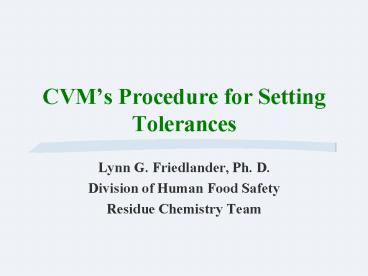CVM - PowerPoint PPT Presentation
1 / 26
Title: CVM
1
CVMs Procedure for Setting Tolerances
- Lynn G. Friedlander, Ph. D.
- Division of Human Food Safety
- Residue Chemistry Team
2
Tolerance Setting
- Chemical residues
- Other approaches
3
Tolerance Setting
- Residue
- Any compound present in the edible tissues of
the target animal which results from the use of
the sponsored compound, including the sponsored
compound, its metabolites, and any other
substances formed in or on food because of the
sponsored compounds use. 21 CFR 500.82 (b)
4
Tolerance Setting
- Office of New Animal Drug Evaluation
- Division of Human Food Safety
- Toxicity data from the model species
- Microbial safety data
- Residue data from the target food-producing
species - Analytical methodology
- Good Laboratory Practices (GLP)
5
Tolerance Setting-Toxicology
- Basic Toxicology Package
- Additional/special toxicology studies
- Calculate the No Observable Effect Level (NOEL)
- Determine the appropriate safety factor
- Calculate the Allowable Daily Intake (ADI)
6
Tolerance Setting-Toxicology
ADI No Observable Effect Level Safety
Factor
7
Tolerance Setting-ToxicologyCalculating the Safe
Concentration
Safe Concentration ADI x 60 kg
consumption factor
8
Tolerance Setting-Toxicology
- The safe concentration is the amount of residue
that can be eaten in any edible tissue each day
for an entire lifetime without exposing the
consumer to residues in excess of the ADI.
9
Tolerance Setting-Residue Chemistry
- Risk Hazard X Exposure
- Mitigates the hazard identified in the toxicology
safety studies by controlling exposure to the
hazard through the assigning of tolerances and
withdrawal periods or milk discard periods, where
needed.
10
Tolerance Setting-Residue Chemistry
- Basic Studies
- Comparative Metabolism-Toxicology Species
- Total Residue and Metabolism-Target Species
- Analytical Method
- Residue Depletion/Withdrawal-Target Species
11
Tolerance Setting-Residue Chemistry
- Comparative Metabolism Study
- Did the toxicology testing evaluate the right
compound(s)? - Qualitative comparison of the metabolic profiles
in the toxicological and food-producing species - Ensures that the toxicological species has been
exposed to the same residues to which humans will
be exposed when they consume products derived
from treated food-producing animals - If profiles are not comparable, more toxicology
testing may be indicated.
12
Tolerance Setting-Residue Chemistry
- Total Residue and Metabolism Study
- Radiolabeled drug
- 1-1.5X the proposed dose
- Proposed route of administration
- Intended duration of treatment/steady state
- Intended species males and females
13
Tolerance Setting-Residue Chemistry
- Total Residue and Metabolism Study
- Determines the MARKER RESIDUE
- the residue that monitors the depletion of total
residues in a tissue - Determines the TARGET TISSUE
- generally, the edible tissue from which residues
deplete most slowly - often, liver or kidney
- rarely, muscle or fat
14
Tolerance Setting-Residue Chemistry
- Total Residue and Metabolism Study
- Provides a METABOLISM PROFILE in the
food-producing animal - for comparison with the metabolism profile of the
toxicological species - Establishes the MARKERTOTAL ratio
- to calculate the tolerance
15
Tolerance Setting-Residue Chemistry
- Analytical Methodology
- Determinative
- measures concentrations of drug residues in
tissue - Confirmatory
- verifies the identity of the drug residue
- Screening
- assesses impact the new drug on pre-existing
residue tests - not required
16
(No Transcript)
17
Tolerance Setting-Residue Chemistry
- Determine the time at which the concentration of
total radiolabeled residues in the target tissue
is less than the target tissue safe concentration - Determine the concentration of the marker residue
in the target tissue at that time using the
proposed analytical methodology
18
Tolerance Setting-Residue Chemistry
- The concentration of the marker residue in the
target tissue at the time the total radiolabeled
residue in the target tissue has depleted to less
than the target tissue safe concentration is the
target tissue TOLERANCE
19
Tolerance Setting-Residue Chemistry
- Can establish tolerances for more than one
tissue, i.e., target tissue and muscle - must have data for the tissue(s) to support the
tolerance assignment(s) - often these data are available as part of the
total residue and metabolism study
20
(No Transcript)
21
Tolerance Setting-Residue Chemistry
- Target tissue tolerance is a monitor for the
depletion of residues from all the edible tissues - When the concentration of the marker residue in
the target tissue is less than the target tissue
tolerance, total residues in all of the edible
tissues are less than their respective safe
concentrations
22
Tolerance Setting-Residue Chemistry
- Non-target tissue tolerance monitors depletion of
residues only from the specific non-target tissue - For example, if we assign a muscle tolerance and
muscle is not the target tissue - Muscle tolerance monitors the depletion of
residues from the muscle - When the concentration of the marker residue in
the muscle is less than the muscle tolerance, the
total residues in the muscle are less than the
muscle safe concentrations - Muscle tolerance does not monitor any other
edible tissues
23
Tolerance Setting-Residue Chemistry
- Tolerance
- links the ADI and safe concentrations of total
radiolabeled residues to cold residues that
result from the use of the proposed market
formulation as measured with the regulatory
analytical method
24
Tolerance Setting-Residue Chemistry
25
Tolerance Setting-Residue ChemistryApplying the
Tolerance
- The preslaughter withdrawal period and, if
applicable, the milk discard period - on the product labeling
- in the relevant section of 21 CFR Part 500
- The established tolerance is codified under 21
CFR 556
26
Tolerance Setting-Residue ChemistryApplying the
ToleranceUS Approvals































